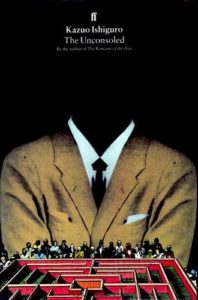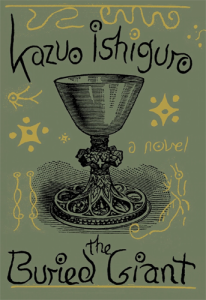
To celebrate Kazuo Ishiguro’s roundly applauded Nobel Prize win, we at Book Marks thought we’d take a glance back through the archives and dig out some of the first reviews for every one of the new laureate’s novels. Enjoy!
**

A Pale View of Hills (1982)
“A delicate, ironic, elliptical novel, A Pale View of Hills means much more than it says … The story, following its narrator’s memory, begins after the bombing of Nagasaki, but that event lies at its center. Barely touched upon, mentioned only by innuendo, the destruction of Nagasaki appears as a vacuum defined only by the misplaced lives and the disjointed modes of survival which derive from it. But in this book, where what is stated is often less important than what is left unsaid, those blanked-out days around the bomb’s explosion become the paradigm of modern life. They are the ultimate example of qualities which the novel celebrates: the brilliance of our negative invention, and our infinite talent for living beyond annihilation as if we had forgotten it.
A Pale View of Hills is Kazuo Ishiguro’s first novel. Its characters, whose bursts of self-knowledge and honesty erase their inspired self-deceptions only briefly, are remarkably convincing. It is filled with surprise and written with considerable charm. But what one remembers is its balance, halfway between elegy and irony.”
–Edith Milton, The New York Times, May 9, 1982
**

An Artist of the Floating World (1986)
“It is not unusual to find new novels by good writers, novels with precise wording, witty phrases, solid characterizations, scenes that engage. Good writers abound – good novelists are very rare. Kazuo Ishiguro is that rarity. His second novel, An Artist of the Floating World, is the kind that stretches the reader’s awareness, teaching him to read more perceptively.
…
“Often with Japanese novels the Western reader may suspect he is missing the point and feel that important references may be getting by him. That is not a problem here. Mr. Ishiguro, though born in 1954 in Nagasaki, has lived in England since 1960. He writes in English and does not require that the reader know the Orient to understand his book. His unnamed city is generic, full of Japanese place names that give it the sound of authenticity. Its people are so embedded in the particulars of their own history and so bound up with their own culture that their conversations alone betray what we need to know of their background. True to a traditional Oriental delicacy and circumspection, the characters are forever emitting small laughs, saying, ‘indeed,’ while essentially disagreeing. As the author never fails to reveal their true intentions, they seem no more ‘inscrutable’ than any of us. The tensions stay tight. And this is what makes Mr. Ishiguro not only a good writer but also a wonderful novelist.”
–Kathryn Morton, The New York Times, June 8, 1986
**

The Remains of the Day (1989)
“The Remains of the Day is a dream of a book: a beguiling comedy of manners that evolves almost magically into a profound and heart-rending study of personality, class and culture.
…
“Kazuo Ishiguro’s tonal control of Stevens’ repressive yet continually reverberating first-person voice is dazzling. So is his ability to present the butler from every point on the compass: with affectionate humor, tart irony, criticism, compassion and full understanding. It is remarkable, too, that as we read along in this strikingly original novel, we continue to think not only about the old butler, but about his country, its politics and its culture.”
–Lawrence Graver, The New York Times, October 8, 1989
*
“Just below the understatement of the novel’s surface is a turbulence as immense as it is slow; for The Remains of the Day is in fact a brilliant subversion of the fictional modes from which it seems at first to descend. Death, change, pain and evil invade the innocent Wodehouse-world. (In Wodehouse, even the Oswald Mosley-like Roderick Spode of the Black Shorts movement, as close to an evil character as that author ever created, is rendered comically pathetic by ‘swanking about,’ as Bertie says, ‘in footer bags.’) The time-hallowed bonds between master and servant, and the codes by which both live, are no longer dependable absolutes but rather sources of ruinous self-deceptions; even the happy yokels Stevens meets on his travels turn out to stand for the post-war values of democracy and individual and collective rights which have turned Stevens and his kind into tragicomic anachronisms. ‘You can’t have dignity if you’re a slave,’ the butler is informed in a Devon cottage, but for Stevens, dignity has always meant the subjugation of the self to the job, and of his destiny to his master’s. What then is our true relationship to power? Are we its servants or its possessors? It is the rare achievement of Ishiguro’s novel to pose big questions – what is Englishness? What is greatness? What is dignity? – with a delicacy and humour that do not obscure the tough-mindedness beneath.”
–Salman Rushdie, The Guardian, August 17, 2012
**

The Unconsoled (1995)
“The Unconsoled itself is beautifully controlled, even-paced, deadpan in spite of all extravagances. Its determined equanimity of tone makes you drowsy, and sometimes you wonder if you’d notice if you dropped off to sleep while you were reading. But there is finally something haunting, even alluring, about the proliferation of obstacles and stories in this book. It’s not that a sense of suspense or of climax is created; far from it. But there is a kind of excitement in Ryder’s stumbling from errand to failed errand, as if nothing were certain in life except the interruption of whatever you are trying to do. We know he’s not going to get anywhere; he’s not going to unravel his relationships, help his friends, please his parents, give his concert or his speech, sort out this terribly self-preoccupied town. But it’s hard work not getting anywhere. Ryder’s endless distraction from his multiplying purposes is so distracting that we can hardly bear it. His life is overwhelmed by irrelevance, buried under pointless but irresistible demands. That’s when the novel ceases to feel like a dream, or only like a dream.
…
“The Unconsoled doesn’t have the concentration of A Pale View of Hills, or its violent and poignant historical background. But it does ask us to think about real and imaginary guilt, and when you realize, only a few pages into the book, that the porter going on about the nobility of the porter’s vocation is parodying Stevens’s line about the dignity of butlering in The Remains of the Day, you get an idea of Ishiguro’s deepest subject: not the sorrow of repression but the comedy and the pathos of the stories we tell ourselves to keep other stories away.”
–Michael Wood, The New York Review of Books, December 21, 1995
*

When We Were Orphans (2000)
“After the exquisitely restrained and limpid prose of his first three novels, Kazuo Ishiguro made an impressive—though to some, baffling—leap from realism into a recondite, dreamlike world in The Unconsoled (1995). His fifth novel melds both these techniques in its rich exploration of the rupture of childhood and the baggage we carry from that ‘foreign land.’ Yet its surreal excursions benefit from clearer signposting, and the meandering longueurs of The Unconsoled have given way to suspense, intrigue and even a lightning-flash denouement.
…
“Ishiguro shows immense tenderness for his characters, however absurd or deluded they may be. If at times the signposting becomes almost too overt, this clarity is welcome in a richly layered novel that brings together themes from the author’s past oeuvre. In its use of an array of techniques to illuminate psychological and political truths, When We Were Orphans confirms Ishiguro as one of Britain’s most formally daring and challenging novelists.”
–Maya Jaggi, The Guardian, April 1, 2000
*
“…while Orphans gets off to a mesmerizing start, it soon devolves into an uneasy composite of his last two novels, costumed in the lurid clothes of thriller. Like The Remains of the Day (1989), it concerns a prim, emotionally repressed hero, whose account of his life is filled with rationalizations and illusions; and like The Unconsoled (1995), it recounts a strange, Kafkaesque journey that represents a voyage into the unconscious. Once again Mr. Ishiguro has given us an unreliable narrator suffering from delusions of grandeur and free-floating anxiety, a self-deluding protagonist who hides his insecurities behind a mask of professional detachment.
Though Orphans has moments of enormous power, it lacks the virtuosic control of language and tone that made Remains of the Day such a tour de force, and it lacks the experimental ambitions of The Unconsoled. Indeed it remains a messy hybrid of a book that recycles Mr. Ishiguro’s favorite narrative techniques while reprising his favorite themes — most notably, his fascination with the ways in which people try to come to terms with the past, and their tendency to conflate the private and the political, the personal and the communal.”
–Michiko Kakutani, The New York Times, September 19, 2000
*

Never Let Me Go (2005)
“Ishiguro serves up the saddest, most persuasive science fiction you’ll read. Set in ‘England, late 1990s,’ the novel posits a technological breakthrough whose effect is to condemn the children of Hailsham to a fate that was, until this novel, unthinkable. Ishiguro’s imagining of the children’s misshapen little world is profoundly thoughtful, and their hesitant progression into knowledge of their plight is an extreme and heartbreaking version of the exodus of all children from the innocence in which the benevolent but fraudulent adult world conspires to place them. We grow up—if we’re lucky—in security and wonder, and afterward are delivered to the grotesque fact of our end. And then? Ishiguro’s dark answer is that the modern desperation regarding death, combined with technological advances and the natural human capacity for self-serving fictions and evasions (look no further than our see-no-evil consumption of animals), could easily give rise to new varieties of socially approved atrocities; one of the many Nietzschean insights of the novel is that successful crimes produce mutations in morality. With its fantastic, inky bleakness, Never Let Me Go itself mutates the meaning of ‘Ishiguroish,’ or ‘Ishiguroesque,’ or whatever epithet sticks to this wonderful writer.”
–Joseph O’Neil, The Atlantic, May, 2005
*
“On one level Ishiguro seems to be saying that art is a con-trick, like religion; that it obscures from us the knowledge or awareness of our own mortality, knowledge that in the case of the Hailsham children is brutally withheld. We believe that art is immortal, and so we represent creativity as an absolute good; but in making this representation to children, are we interfering with their right to know about and accept death?
…
“Never Let Me Go, like the clones it portrays, has in the end something of a double nature, for it both attracts and annihilates. Or perhaps it is a book that requires two readers, the reader who can be blind to its ugly visage, and the reader who can see into its delicately conflicted soul. For those who perceive the latter, the novel’s bleak horror will leave a bruise on the mind, a fetter on the heart.”
–Rachel Cusk, The Guardian, January 28, 2011
*

The Buried Giant (2015)
“The Buried Giant is a melancholy book, and the mist that breathes through it is a melancholic mist. The narrative tone is dreamlike and measured. There are adventures, sword fights, betrayals, armies, cunning stratagems and monsters killed, but these things are told distantly, without the book’s pulse ever beating faster. They are described unflinchingly, precisely, sometimes poetically. Enemies are slain, but the deaths are never triumphant. A culmination of a planned trap for a troop of soldiers, worthy of a whodunit, is described in retrospect, once we already know what must have happened. Stories drift toward us in the narrative like figures in the mist, and then are gone. The excitements that the book would deliver were this a more formulaic or crowd-pleasing novel are, here, when they appear, not exciting, perhaps because they would be young people’s adventures, and this is, at its heart, a book about two people who are now past all adventure. Axl and Beatrice, gentle and caring and kind, wish only to survive, to reach their son, to be together. They need to remember their past, but they are afraid of what those memories might bring them.
…
“Ishiguro is not afraid to tackle huge, personal themes, nor to use myths, history and the fantastic as the tools to do it. “The Buried Giant” is an exceptional novel, and I suspect my inability to fall in love with it, much as I wanted to, came from my conviction that there was an allegory waiting like an ogre in the mist, telling us that no matter how well we love, no matter how deeply, we will always be fallible and human, and that for every couple who are aging together, one or the other of them — of us — will always have to cross the water, and go on to the island ahead and alone.”
–Neil Gaiman, The New York Times, February 25, 2015
*
“Unfortunately, Ishiguro’s new novel, The Buried Giant, does not generate the kind of pressure that might wring shadows from the bemusing transparency of its narration. Thematically, it has obvious connections with the author’s earlier analyses of historical repression, and with the blasted theology of Never Let Me Go. It also has some consonance with the Kafkaesque dreamscape of The Unconsoled. But in his new novel Ishiguro runs the great risk of making literal and general what is implicit and personal in his best fiction. He has written not a novel about historical amnesia but an allegory of historical amnesia, set in a sixth- or seventh-century Britain, amok with dragons, ogres, and Arthurian knights. The problem is not fantasy but allegory, which exists to literalize and simplify. The giant is not buried deeply enough.
…
“Never Let Me Go is a miraculous novel, because it is an allegory that points straight at us—at ordinary, obedient, unfree human life. The Buried Giant points everywhere but at us, because its fictional setting is feeble, mythically remote, generic, and pressureless; and because its allegory manages somehow to be at once too literal and too vague—a magic rare but unwelcome.
–James Wood, The New Yorker, March 23, 2015
***

